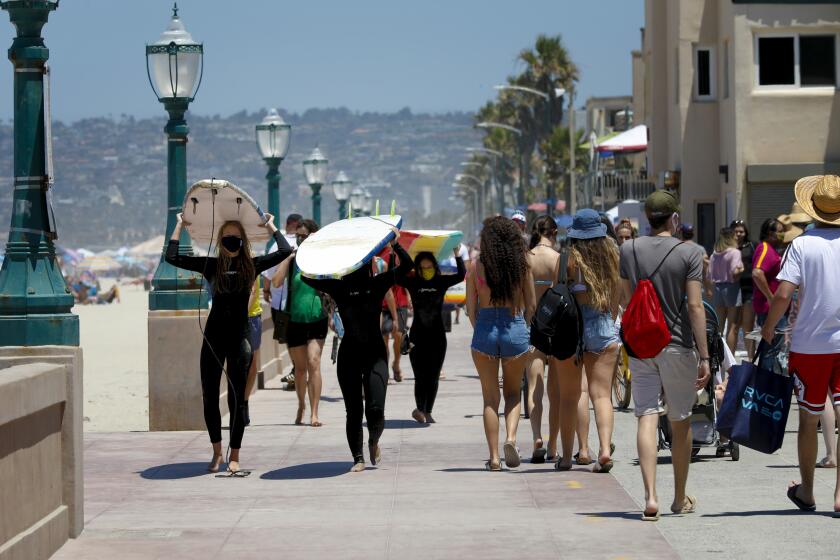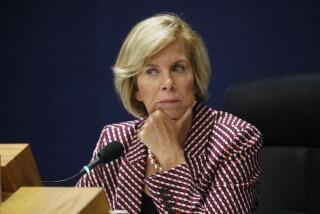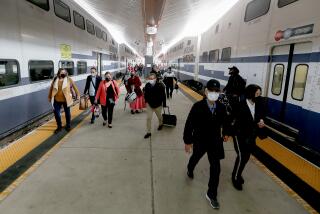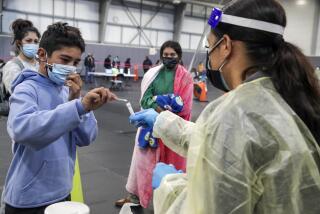Coronavirus testing shortages worsen across L.A.
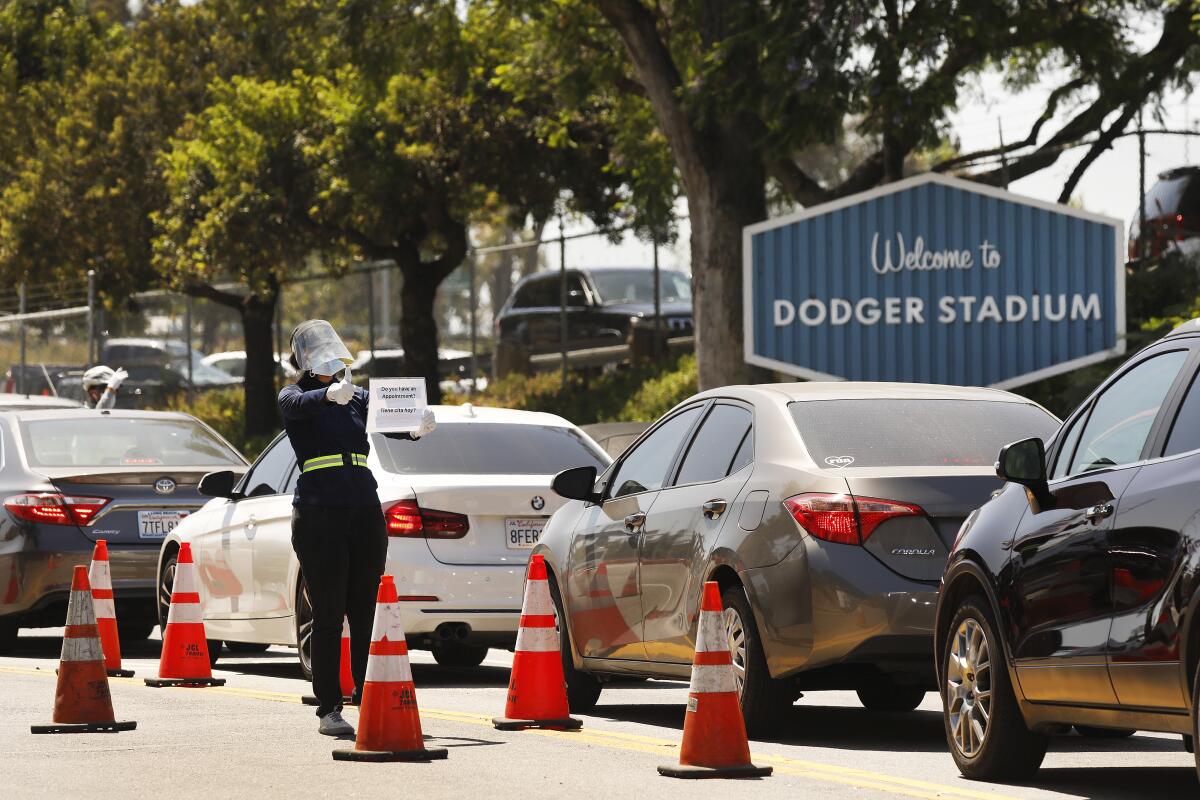
After going to a socially distanced gathering late last month, Harrison Faigen wanted to get a coronavirus test.
He waited about a week after the June 26 party, knowing that officials have said it takes time for a viral load to appear in a person’s system after potential exposure.
Faigen tried for two days over the weekend to land an appointment, which he eventually secured for Monday. He was luckier than a lot of residents in Los Angeles County, where the requests for testing have been greater than the availability.
Although public health officials have said that testing capacity is expanding, limited availability has stymied those seeking to be tested for weeks.
“There continues to be high demand for testing services,” Los Angeles County Health Services Director Dr. Christina Ghaly said Monday.
Now, public health officials are bracing for the grimmest phase of the cycle: a spike in COVID-19 fatalities.
The site of the county’s largest COVID-19 testing facility in Los Angeles County — Dodger Stadium — resumed testing Tuesday after a four-day closure during the July Fourth holiday. But same-day and next-day appointments are currently unavailable.
That’s also the case at city- and county-run testing sites throughout the area and at other venues, such as CVS pharmacies, which are now listed on the county’s website but do not have availability for individuals who are asymptomatic, those without underlying health conditions or those who don’t work in high-risk environments.
On Tuesday, Los Angeles County announced that it is committing $400,000 to support staffing-related costs at testing sites operated by the nonprofit organization Community Organized Relief Effort. The group, known as CORE and founded by actor Sean Penn, has been working with L.A. officials to run operations at some coronavirus drive-through testing facilities since April.
CORE conducts testing at Dodger Stadium and five other sites in the city. It costs $600,000 to $800,000 for the company to operate those facilities each month, CORE co-founder Ann Lee said.
Lee said the demand for testing noticeably increased around Memorial Day. She believes that’s largely due to the expanded communication about testing.
“Testing has become more normalized. Initially, there was a lot of mistrust around it,” she said. “I do think the increase in positive communication around it has meant that more people are interested in getting tested.”
In response to the high demand for testing, CORE and testing company Curative are partnering to implement a new system that will be less reliant on government funds and the city’s limited budget. Curative will allow insurance companies to be billed for COVID-19 testing, while ensuring that residents being tested don’t have to pay out of pocket. According to CORE, those who are uninsured would be covered by the city of Los Angeles and the CARES Act.
The operation would still work with the city and the Los Angeles Fire Department, which will have a continued presence at testing sites.
The results of a survey by the USC Dornsife Center for Economic and Social Research were revealed Monday amid a major increase in new coronavirus cases and hospitalizations.
On Monday, the city administered 2,800 tests, according to Andrea Garcia, Mayor Eric Garcetti’s press secretary. Some 80,000 will be provided throughout the week, she said.
The county is currently able to test 26,000 people per day. County officials said Monday that they are looking to add five to 10 more testing sites and that additional slots are planned to open this week, though it’s unclear how many.
Lee said it can take about two weeks to launch a new testing site capable of serving 2,500 people. The process would require a city or county to procure and lease a location. A company such as CORE would then have to hire and train people to conduct tests, and obtain enough personal protective equipment.
“It’s a function of staffing up,” she said.
The surge in coronavirus testing requests comes largely at the behest of public health officials, who have stressed the need for testing if individuals have attended social gatherings or protests and have cautioned that asymptomatic carriers of the virus could be super-spreaders.
Faigen, 28, isn’t showing any symptoms and doesn’t think he was exposed to the virus at the gathering he attended. Still, he wanted to err on the side of caution.
But after he was tested, an attendant told him it would take seven to 10 days for his results — more than two weeks after a possible infection.
“It’ll be good for peace of mind,” he said. “But it’s kind of useless at this point.
“I’m luckier than most in that I work remotely and am able to self-quarantine right now. Thankfully I’m not in a position where I have to interact with people who are at risk.”
The delay it takes for many people to get results may be of particular concern as officials have estimated that 1 in 140 people in L.A. County are unknowingly infected with the virus.
Test results are the only true barometer officials have for understanding changes in the rate of the virus’ transmission.
In L.A. County, infection numbers have surged. Health officials on Tuesday reported 4,015 additional cases, the highest number of infections the county has recorded in a single day. The number is based largely on roughly 2,000 test results that were backlogged from July 2 to July 5. The additions bring the number of cases in L.A. County to more than 120,000, nearly half the state’s total.
The seven-day average for the county’s daily positivity rate — those who test positive for the virus — has also climbed to 11.6%. On Monday, it was just below 10%.
Although the number of infections is continuing to surge in California, backlogged test results have resulted in some of the high numbers reported over the past few days. On Sunday, Los Angeles County officials announced a total of 7,232 new COVID-19 cases from Thursday, Friday and Saturday, after a delay in records. Friday previously marked the highest single-day total of new cases in the county: 3,187.
Results reported on any given day account for virus exposure occurring roughly two weeks prior. Public Health Director Barbara Ferrer said it would take about two weeks to know how Fourth of July celebrations affected the spread.
“We won’t know for another 14 days what the impact of the holiday weekend is,” Ferrer said, noting that extensive gatherings over the Memorial Day holiday led to an increase in infections two weeks later.
More to Read
Start your day right
Sign up for Essential California for news, features and recommendations from the L.A. Times and beyond in your inbox six days a week.
You may occasionally receive promotional content from the Los Angeles Times.
